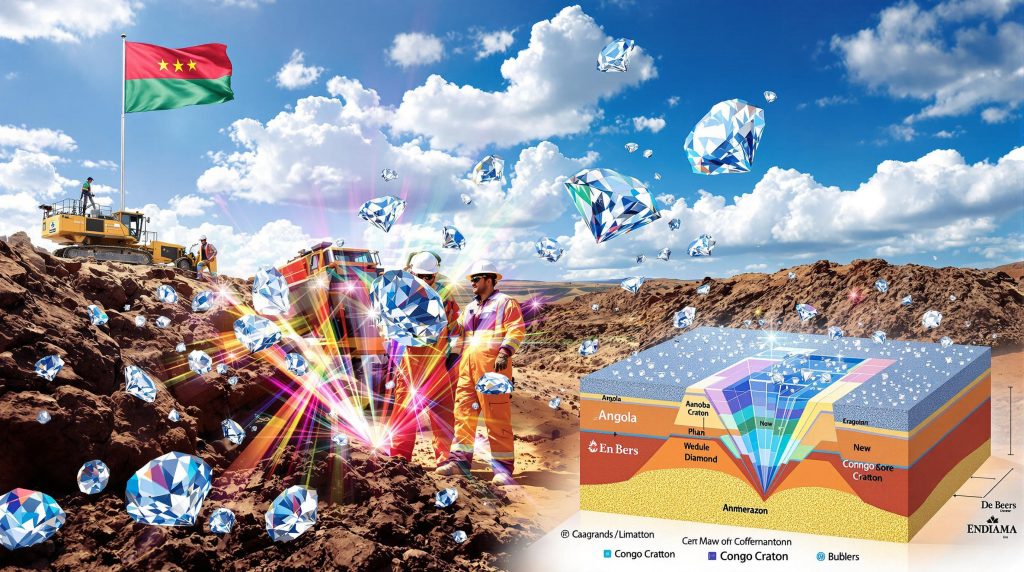Angola's Diamond Industry Breakthrough: De Beers-Endiama Partnership Discovers New Kimberlite Field
The recent discovery of a new kimberlite field in Angola represents a significant milestone in the country's diamond industry. This breakthrough comes through a strategic partnership between De Beers Group, a global leader in diamond exploration and mining, and Endiama, Angola's national diamond company. The collaboration builds upon formal agreements established in recent years, including mineral investment contracts signed in April 2022 and a memorandum of understanding finalized at Mining Indaba in February 2024.
This discovery marks De Beers' first kimberlite field discovery in more than 30 years, highlighting both the rarity of such finds and Angola's significant geological potential in the diamond sector. The partnership could potentially reshape Angola's economic landscape while providing a much-needed boost to the global natural diamond supply as the mining industry evolution continues to face resource challenges.
The Strategic Partnership Behind Angola's Diamond Breakthrough
The De Beers-Endiama partnership combines international expertise with local knowledge, creating a powerful exploration alliance. This collaboration represents a significant shift in Angola's approach to diamond development, embracing international partnerships to maximize the potential of its natural resources.
De Beers brings world-class exploration capabilities and technical knowledge gained from decades of global operations. Meanwhile, Endiama contributes crucial understanding of Angola's geological landscape and navigating local operational environments. This complementary skill set has proven essential to the recent discovery success.
Al Cook, De Beers Group CEO, expressed strong confidence in the partnership: "Angola is, in our view, one of the best places on the planet to look for diamonds, and this discovery reinforces our confidence. It is a powerful reminder of what can be achieved through partnership, and I commend President Lourenco and his government for all the work they have done to enhance transparency, adopt international best practices and create a business-friendly environment, all of which has enabled us to return to Angola and seek new sources of supply."
The joint venture structure distributes both risk and potential rewards between the partners, creating alignment of interests crucial for long-term project success. This balanced approach has become increasingly important in modern mine planning where capital requirements and development timelines are substantial.
How Was the Kimberlite Field Discovered?
The discovery process followed a methodical exploration approach that demonstrates modern diamond prospecting techniques. This systematic methodology highlights the technical expertise that De Beers brings to the partnership.
The Exploration Timeline and Process
The exploration journey began in March 2025 with comprehensive airborne surveys that identified several high-priority target clusters. These surveys employed advanced geophysical sensing equipment to detect subtle anomalies that might indicate kimberlite formations beneath the surface.
By July 2025, the exploration team had mobilized drilling equipment to the most promising target area. Success came quickly, with the very first drill successfully intersecting kimberlite deposits, confirming the presence of the diamond-bearing rock formation.
This initial success has triggered plans for expanded exploration activities. Future phases will include additional drilling to determine the extent of the kimberlite field, ground geophysical surveys to map the formation in greater detail, and laboratory analysis to determine kimberlite type and diamond potential.
Technical Assessment Methods
Modern diamond exploration combines several sophisticated technologies and assessment methods:
- Remote sensing technology provides initial screening of large areas, identifying surface features and anomalies that might indicate kimberlite presence
- Geophysical analysis helps map subsurface structures through techniques like magnetic and gravitational surveys
- Core sampling through targeted drilling provides physical evidence of kimberlite presence and composition
- Laboratory testing will determine the mineralogical characteristics of the kimberlite and assess its diamond-bearing potential
This multi-layered approach significantly improves exploration efficiency compared to historical methods, allowing teams to focus resources on the most promising targets while minimizing environmental impact through advanced geological modelling techniques.
Why is This Discovery Historically Significant?
This kimberlite field discovery marks De Beers' first such find in over three decades, highlighting both the rarity of major diamond discoveries and the potential significance of this particular find. In an industry where new discoveries have become increasingly elusive, this breakthrough represents a substantial achievement.
Historical Context of Diamond Discoveries
The global diamond industry has faced a persistent challenge in recent decades: declining discovery rates of economically viable diamond deposits. This trend has led to concerns about future natural diamond supply and increased focus on extending existing mine lifespans rather than developing new operations.
The 30-year gap since De Beers' last kimberlite field discovery underscores the exceptional nature of this achievement. The company's last comparable discovery occurred in the early 1990s, making this Angola find particularly noteworthy within industry circles, as reported by De Beers in their official announcement.
Angola's established position in global diamond production makes this discovery even more significant. The country already ranks among the world's top diamond producers by value, and this new field could potentially enhance its position further.
Industry Perspective: Diamond discoveries of this nature have become increasingly rare worldwide, with most production coming from extensions of existing operations rather than entirely new fields. This find suggests Angola may have untapped potential that could significantly impact global supply dynamics over the coming decade.
What Makes Angola a Prime Diamond Exploration Target?
Angola has long been recognized for its diamond potential, but various factors have limited full exploration and development. Recent changes have created new opportunities for international partnerships to access the country's geological riches.
Angola's Diamond Geology and Potential
Angola benefits from exceptional geological advantages for diamond formation. The country sits within the Congo Craton, a stable geological formation that provides the perfect conditions for diamond creation and preservation over millions of years. This ancient continental core has been a source of diamonds across central Africa.
Despite already ranking among the world's top diamond producers by value, Angola's potential remains significantly underutilized. Large portions of the country with promising geology remain underexplored using modern techniques, creating substantial opportunities for new discoveries and assessment of mineral deposit tiers.
Angolan diamonds have established a strong reputation for quality. The country produces a high percentage of gem-quality stones, and many Angolan diamonds are known for their exceptional clarity, color, and size. This quality profile enhances the economic potential of any new discoveries.
As De Beers Group CEO Al Cook stated, Angola is considered "one of the best places on the planet to look for diamonds" from a geological perspective. This assessment from one of the industry's leading authorities highlights the exceptional potential that exists within the country's borders.
How Might This Discovery Impact Angola's Economy?
The potential economic implications of this discovery extend beyond the immediate mining sector, potentially influencing Angola's broader economic development strategy. While still in early stages, successful development could provide meaningful benefits across multiple areas of the economy.
Potential Economic Benefits
Export diversification represents one of the most significant potential impacts. Angola's economy has been heavily dependent on oil exports, making it vulnerable to petroleum price fluctuations. Diamond production from new sources could strengthen efforts to create a more balanced economic portfolio.
Diamond operations typically create substantial employment opportunities at multiple skill levels. Modern mining operations require everything from specialized geologists and engineers to equipment operators and support staff. The multiplier effect creates additional indirect jobs in supporting industries and services.
Mining developments often catalyze regional infrastructure improvements that benefit broader economic activity. Road networks, power generation, water systems, and telecommunications infrastructure developed for mining operations can serve surrounding communities and enable other economic activities.
Increased diamond production could generate additional government revenue through taxes, royalties, and direct ownership interests. When managed transparently and effectively, these funds can support broader development priorities including education, healthcare, and diversification initiatives.
Economic Consideration: The full economic impact depends on numerous factors including the size and quality of the discovered resource, development approach, local content integration, and government policy implementation. Realizing the maximum benefit requires careful planning and management throughout the development process.
What Reforms Have Made This Partnership Possible?
Angola's government has implemented significant reforms to attract international mining investment, creating conditions that enabled De Beers' return to the country after a long absence. These changes reflect a broader shift in Angola's approach to resource development, as reported by Reuters.
Key Governance and Regulatory Changes
Enhanced transparency has been a cornerstone of Angola's mining sector reforms. Improved reporting and oversight mechanisms have increased investor confidence by providing greater clarity on licensing processes, ownership structures, and revenue flows. These changes align with international transparency initiatives for extractive industries.
The adoption of international standards in mining governance has signaled Angola's commitment to creating a globally competitive investment environment. These standards cover areas from resource reporting to environmental management and social responsibility, creating a framework familiar to international operators.
Business-friendly policies have streamlined permitting and regulatory processes that previously created barriers to investment. Reducing bureaucratic obstacles and creating predictable administrative pathways has significantly improved Angola's attractiveness for mining investment.
Strengthened legal frameworks for foreign investors have provided greater certainty around property rights, dispute resolution, and profit repatriation. These protections are particularly important in capital-intensive industries like diamond mining where investment horizons span decades.
De Beers Group CEO Al Cook specifically commended "President Lourenco and his government for all the work they have done to enhance transparency, adopt international best practices and create a business-friendly environment," highlighting the importance of these reforms in enabling the partnership.
What Happens Next in the Development Process?
The discovery represents just the first step in a lengthy process to determine commercial viability and potential development options. Several critical phases must be completed before any production decision can be made.
Next Steps in Evaluation and Development
Resource assessment forms the foundation of any development decision. Extensive drilling programs will determine the quantity and quality of potential diamond resources within the kimberlite field. This phase typically requires 2-3 years of systematic work to establish a reliable resource estimate and thorough drill results interpretation.
Once resource parameters are established, economic evaluation will analyze commercial viability and development options. This process considers capital requirements, operating costs, expected diamond values, and market conditions to determine if economically viable development is possible.
Environmental studies will assess potential impacts and mitigation strategies across all project phases. Modern mining operations must meet rigorous environmental standards from exploration through closure, requiring detailed baseline studies and management plans.
Community engagement begins early and continues throughout the project lifecycle. Building constructive relationships with local stakeholders helps ensure project designs address community concerns and create opportunities for shared value creation.
If earlier phases indicate commercial viability, development planning will create detailed operational plans covering mine design, processing facilities, infrastructure requirements, and production scheduling. This comprehensive planning phase typically takes 1-2 years to complete.
| Development Phase | Typical Timeline | Key Activities |
|---|---|---|
| Resource Assessment | 2-3 years | Drilling, sampling, geological modeling |
| Economic Evaluation | 6-12 months | Financial modeling, market analysis, option studies |
| Environmental Studies | 1-2 years | Baseline data collection, impact assessment, management planning |
| Community Engagement | Ongoing | Stakeholder mapping, consultation, agreement development |
| Development Planning | 1-2 years | Engineering design, infrastructure planning, permitting |
| Construction | 2-3 years | Site preparation, facility construction, commissioning |
How Does This Compare to Other Recent Diamond Discoveries?
The global context of diamond exploration helps frame the significance of this particular find within industry trends. The Angola discovery stands out in an environment where major new diamond finds have become increasingly rare.
Global Diamond Exploration Context
Declining discovery rates have characterized the diamond industry in recent decades. New economically viable diamond deposits have become increasingly difficult to find despite advances in exploration technology. Most major diamond-producing regions were discovered in the 20th century, with few significant new fields identified in recent years.
Production concentration has resulted from this discovery challenge, with most new production coming from expansions of existing operations rather than greenfield developments. This trend has raised concerns about long-term natural diamond supply as existing mines gradually deplete their resources.
Exploration challenges extend beyond simple discovery rates. Rising costs and technical challenges in diamond exploration have made investment decisions increasingly difficult, particularly given the high failure rate inherent in diamond exploration. Only a small percentage of identified kimberlites contain economically viable diamond concentrations.
Market dynamics have further complicated exploration investment. Changing consumer preferences and growing competition from laboratory-grown diamonds have created uncertainty about long-term natural diamond demand, influencing capital allocation decisions for exploration programs.
Against this challenging backdrop, the De Beers-Endiama partnership discovers new kimberlite field in Angola representing a notable success story that could potentially influence broader industry exploration strategies and investment patterns.
What Challenges Might the Project Face?
Despite the promising initial discovery, several challenges could affect the ultimate development of any commercial operation. Understanding these potential hurdles provides important context for evaluating the project's prospects.
Potential Development Hurdles
Resource quality represents perhaps the most fundamental uncertainty. Not all kimberlites contain economically viable diamond concentrations, and even within diamond-bearing kimberlites, stone quality and value can vary dramatically. Extensive sampling and analysis will be required to determine if commercial development is justified.
Infrastructure limitations often present significant challenges in diamond developments. Remote locations may require substantial investment in roads, power generation, water supply, and accommodation facilities. These infrastructure costs can significantly impact project economics, particularly for smaller diamond deposits.
Market conditions introduce another layer of complexity. Diamond prices fluctuate based on global supply and demand dynamics, and projections over the multi-decade life of a diamond mine involve considerable uncertainty. These market factors must be carefully considered in development decisions.
Environmental considerations have become increasingly important in modern mining. Comprehensive environmental management systems must address impacts on water resources, biodiversity, air quality, and land use. Developing effective solutions for these challenges requires significant expertise and investment.
Community relations play a critical role in project success. Modern mining operations must build positive relationships with local communities and demonstrate tangible benefits from development. Failure to establish strong community partnerships can lead to operational challenges and reputational damage.
How Might This Affect the Global Diamond Industry?
The potential implications of this discovery extend to the broader diamond industry, including possible effects on global supply dynamics. While still early in the evaluation process, the Angola find could influence several aspects of the industry landscape.
Industry-Wide Implications
Supply diversification represents one potential impact if commercial development proceeds. A significant new diamond source would provide welcome diversification in a market where production has become increasingly concentrated among a small number of major mines and producers.
The discovery demonstrates continued market confidence in natural diamond exploration potential, potentially encouraging increased investment in exploration activities. This positive signal comes at a time when some industry observers have questioned the future of new natural diamond discoveries.
Successful development could stimulate renewed industry investment in exploration activities, particularly in regions with similar geological characteristics. Exploration tends to follow success, and a major new discovery often triggers increased interest in surrounding areas.
Any significant new producer would influence the competitive landscape among major diamond producers. The strategic positioning of companies within the industry could shift in response to new supply sources and ownership structures.
Industry Perspective: While one discovery won't transform global supply dynamics overnight, this find represents an important indicator that untapped diamond resources still exist in favorable jurisdictions. The long-term impact will depend on development decisions and ultimate production volumes.
FAQ: Angola's New Kimberlite Discovery
What is a kimberlite field and why is it important for diamonds?
Kimberlite is an igneous rock formation that serves as the primary source of diamonds. These volcanic pipes extend deep into the Earth's mantle where diamonds form under extreme pressure and temperature. Kimberlites are essentially ancient volcanic conduits that brought diamonds from depths of 150-200 kilometers to near the Earth's surface.
Not all kimberlites contain diamonds, and even fewer contain them in commercially viable concentrations. Industry estimates suggest only about 1% of kimberlites contain economic diamond deposits. This rarity makes new kimberlite field discoveries particularly significant for the diamond industry.
Kimberlite fields typically contain multiple individual pipes or formations across a geographic area. The discovery of a field rather than a single pipe suggests potential for multiple diamond sources within the exploration area, enhancing the economic significance of the find.
How long does it typically take to develop a new diamond mine after discovery?
The development timeline for a new diamond mine typically spans 5-10 years from initial discovery to commercial production. This extended timeline reflects the complex nature of diamond deposit evaluation and mine development.
The process includes multiple phases:
- Detailed exploration drilling (2-3 years)
- Resource evaluation and economic assessment (1-2 years)
- Feasibility studies and engineering design (1-2 years)
- Environmental impact assessments and permitting (1-3 years)
- Construction and commissioning (2-3 years)
These phases often overlap but still require significant time to complete properly. The process demands substantial capital investment, often reaching hundreds of millions or even billions of dollars for large-scale operations.
The technical expertise required spans multiple disciplines, including geology, mining engineering, processing technology, environmental science, and project finance. This complexity contributes to the extended development timeline.
What makes Angola attractive for diamond exploration compared to other regions?
Angola combines several favorable factors for diamond exploration that create a compelling value proposition for international mining companies.
The country's position within the diamond-rich Congo Craton provides proven geological potential. This ancient, stable geological formation has produced significant diamon
Want to Catch the Next Major Mineral Discovery?
Discovery Alert's proprietary Discovery IQ model scans the ASX daily, delivering real-time notifications when significant mineral discoveries are announced, turning complex data into actionable investment opportunities. Visit the Discovery Alert discoveries page to explore how historic mineral discoveries have generated substantial returns for early investors.




